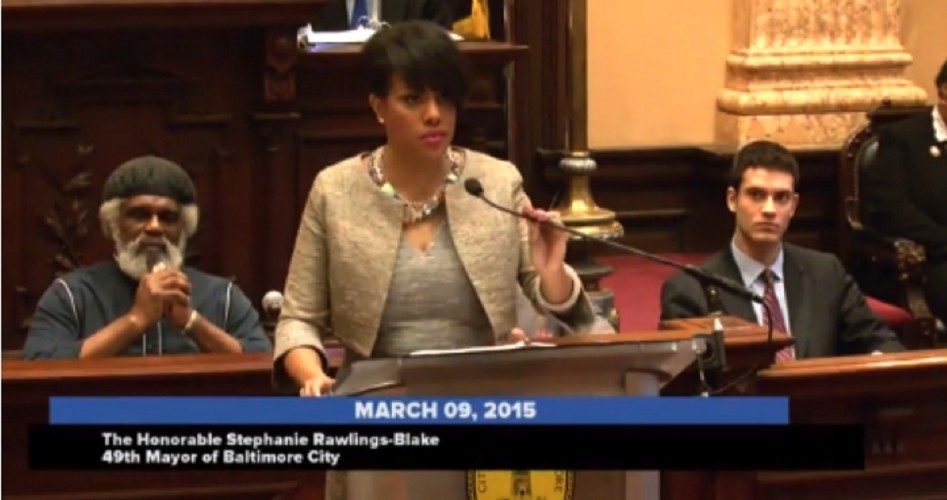
Baltimore mayor Stephanie Rawlings-Blake has a unique (one would hope) method for dealing with rioters: Let them destroy property.
The mayor made this shocking admission on Sunday, saying at a press conference that during her city’s weekend riots, she wanted to “give those who wished to destroy, space to do that.”
As many already know, rioters damaged property and created mayhem in Baltimore the past two days, ostensibly as a reaction to the case of Freddie Gray, a criminal suspect who died April 19 in police custody.
As to Blake’s response, here is her complete statement:
I made it very clear that I work with the police and instructed them to do everything that they could to make sure that the protesters were able to exercise their right to free speech.
It’s a very delicate balancing act. Because while we try to make sure that they were protected from the cars and other things that were going on, we also gave those who wished to destroy, space to do that as well. And we worked very hard to keep that balance and to put ourselves in the best position to de-escalate.
For sure and as the picture here shows, there were peaceful protesters in Baltimore this past weekend. But then there were the “others,” miscreants whose “protest is just a riot camouflaged in self-righteousness,” as Fusion’s Daniel Rivero put it. These are thugs to whom any excuse is sufficient to loot, vandalize, burn, and commit violence, which some people think is “fun.” This, mind you, was given to a reporter, wrote Colin Flaherty, as an explanation for “why so many ‘teens’ are so eager to be so violent.” It’s fun.
And while Mayor Blake was allowing thugs their “fun,” others are encouraging the world’s Mayor Blakes. For example, the aforementioned Rivero wrote that if the worst of Baltimore rioting is in fact behind us, “there could be a case for other leaders to handle widespread protests like this differently. Because sometimes, punching the punching bag really does take your anger away. And on the flip side, telling you not to punch the punching bag can only make you angrier.”
Or perhaps just tell the miscreants to scream “Serenity now!” (TV show reference). The point Rivero misses is that a punching bag is an inanimate object designed to be punched. In Baltimore, good residents were the punching bag. And one could wonder: If disgruntled citizens attack the mayor’s residence to “protest” her abdication of responsibility, will they be given “room to destroy”? It could be that the punching-bag theory is a tad more appealing when you’re the puncher — or a spectator — and not the bag.
Rivero also wrote, “It might have been worth the calculation from city officials to sacrifice a little public property for the sake of allowing protesters to vent their anger, hopefully quelling unrest in the long run.”
Trading the Sudetenland for “peace in our time”?
Rivero has it backwards. Blake’s strategy is called “appeasement” — and it never works over the long run. It’s as with a child: Allowing a type of misbehavior may prevent a tantrum at the moment, but it conditions the kid to feel he can get away with being bratty. The result is worsening behavior over time unless and until you clamp down hard enough to deter it.
Interestingly, I tweeted some of the above sentiments to Rivero, and he responded with “Cop cars in particular are the punching bag, in my opinion. It’s symbolism.”
But the reality is that rioters don’t just damage property; they also hurt innocent people. And Baltimore this weekend was no exception. Here’s video of one punching bag — a wheelchair-bound woman. Much anger was vented pelting her and those around her with objects large and small. (This, not to mention the six injured police officers who, I imagine, come as a package deal with the cop cars.) Of course, given Mayor Blake’s penchant for cooking crime statistics, we may never know the true extent of victimization. But more on that later.
We also won’t be informed about the riot’s racial component, say critics. As blogger SooperMexican puts it, giving a first-person perspective on the attacks, “Of course, we’re going to be told the protest and looting had nothing to do with race, right? Is that why people protected their businesses by putting … ‘black owned’ signs out front?”
As for the symbolism Rivero speaks of, one might also ask: If he has a son, will he teach him that attacking cop cars is an appropriate way to “vent anger”? While many today understandably bemoan the militarization of police and stress that they must remain “police,” appropriate respect for them among the citizenry is also necessary. Without it, lawlessness proliferates and, should this become extreme enough, tyranny will step in to restore order. This is why “destabilization” of a target nation is one of the steps toward Marxist revolution. For an eternal law exists: If people will not submit to just authority, they will end up suffering under the yoke of unjust authority.
If you want to riot, however, you probably couldn’t pick a better place than Baltimore because Mayor Blake has a history of giving those who wish “to destroy, space to do that.” As Colin Flaherty wrote in his 2014 piece “Black Crime in Baltimore High — but Should be Higher,” “Crime in Baltimore is dropping like a pile of hot rocks.” And the reason why, he continues, is simple, “It is hard to get arrested there.”
As an example, Flaherty points to an attack on a Jewish dentist and relates the details of the case:
More than 20 witnesses. A crime scene confession. A shaken victim, willing to press charges. And what happened?
Nothing.
Then, citing another space-to-destroy riot — one that didn’t make national news partially because the police never recorded it — Flaherty quoted reporter Peter Herman and wrote that it “was ‘normal and routine’ to grizzled observers of the gritty Baltimore crime beat. Police ‘made no arrests, saw no crime, had no reason to make an announcement. There’s not even a report — it’s just something that happens,’ he [Hermann] said.”
In fact, it happens so much that then-Maryland governor Martin O’Malley recommended that Mayor Blake put more police on the ground. But as Flaherty wrote:
She had her own plan and it was working just fine: Just stop arresting people. When O’Malley was mayor, the city collared 100,000 miscreants a year. Last year [2013], they nabbed 50,000.
This allows the Mayor to brag to anyone willing to listen that violent crime in Baltimore is down — 45 percent since the year 2000.
So as Rivero surmised, after Blake’s space-to-destroy tactics, we just may not hear about another Baltimore riot.
That is, we may not hear about it.
Update: The mayor has now issued a denial, claiming that she “did not instruct police to give space to protesters seeking to create violence.” Of course, this lies in contrast to what she said on Sunday, prior to receiving criticism for her outrageous admission.



